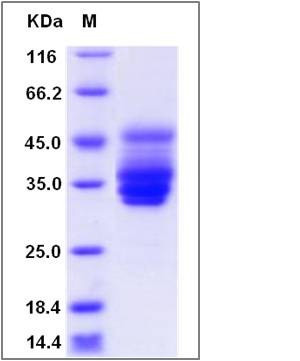Human IFITM3 Protein (Fc Tag)
1-8U,DSPA2b,IP15
- 100ug (NPP3980) Please inquiry
| Catalog Number | P12431-H04H |
|---|---|
| Organism Species | Human |
| Host | Human Cells |
| Synonyms | 1-8U,DSPA2b,IP15 |
| Molecular Weight | The recombinant human IFITM3/Fc is a disulfide-linked homodimer. The reduced monomer comprises 293 amino acids and has a predicted molecular mass of 32.9 kDa. The apparent molecular mass of the monomer is approximately 33-45 kDa in SDS-PAGE under reducing conditions due to glycosylation. |
| predicted N | Asp |
| SDS-PAGE |  |
| Purity | > 99 % as determined by SDS-PAGE |
| Protein Construction | A DNA sequence encoding the human IFITM3 (NP_066362.2) (Met1-His57) was expressed, fused with the Fc region of mouse IgG1 at the N-terminus. |
| Bio-activity | |
| Research Area | Cancer |Invasion microenvironment |Angiogenesis |Adhesion Molecules in Angiogenesis |Extracellular Matrix |Structures | |
| Formulation | Lyophilized from sterile PBS, pH 7.4 1. Normally 5 % - 8 % trehalose and mannitol are added as protectants before lyophilization. Specific concentrations are included in the hardcopy of COA. |
| Background | Interferon-induced transmembrane protein 3 (IFITM3) belongs to the CD225 family. To replicate, viruses must gain access to the host cell's resources. Interferon (IFN) regulates the actions of a large complement of interferon effector genes (IEGs) that prevent viral replication. The interferon inducible transmembrane protein family members, IFITM1, 2 and 3, are IEGs required for inhibition of influenza A virus, dengue virus, and West Nile virus replication in vitro. IFITM3 is an IFN-induced antiviral protein that mediates cellular innate immunity to at least three major human pathogens, namely influenza A H1N1 virus, West Nile virus (WNV), and dengue virus (WNV), by inhibiting the early step(s) of replication. It is both necessary and sufficient for preventing the emergence of viral genomes from the endosomal pathway. Viral pseudoparticles were inhibited from transferring their contents into the host cell cytosol by IFN, and IFITM3 was required and sufficient for this action. IFITM3 overexpression is sufficient for this phenotype. Moreover, IFITM3 partially resides in late endosomal and lysosomal structures, placing it in the path of invading viruses. |
| Reference |
